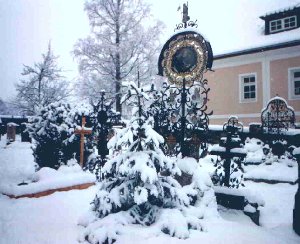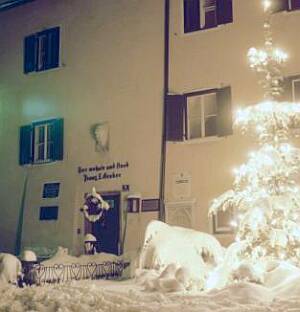A Christmas Tale of Three Cities
Wagrain, Austria
Hallein, Austria
Jacksonville, Florida
by Bill Egan, Christmas Historian
On Christmas Eve in Austria, pilgrims gather
around the grave of Joseph Mohr in Wagrain and the grave of Franz Gruber
in Hallein. Ceremonies are held to honor the memory of the two men who
wrote the world's best-loved Christmas carol - "Silent Night."
In 1816 Joseph Mohr, a priest stationed at a pilgrim church in Mariapfarr, wrote a six-stanza poem, "Stille Nacht! Heilige Nacht!" Two years later, after a transfer to St. Nicholas Church in Oberndorf, he asked a friend to create a melody and guitar accompaniment for his poem. Thus a song was born that would reach around the globe to become a major part of Christmas celebrations from great stone cathedrals in Europe to small palm-thatched huts in the South Pacific.

Early in December, a Christmas tree is placed on Mohr's grave in the
small cemetery outside the church in Wagrain where he was pastor. Nearby
is the Joseph Mohr School named after the man who helped create Austria's
Christmas treasure. On Christmas Eve, villagers and visitors carry candles and
lanterns as they head for the churchyard for a memorial service that
ends with everyone singing "Stille Nacht! Heilige Nacht."
On December 24, 1818, Franz Xaver Gruber was visited at his home in Arnsdorf by his friend Joseph Mohr. The young priest from nearby Oberndorf asked him to write a melody and guitar accompaniment for a poem he had written two years earlier. In a few hours a new Christmas carol was ready to be sung at Mass in St. Nicholas Church. There were no famous singers to perform the carol. There was no media hype. Instead, a priest and a choirmaster, backed by the church choir, sang a simple carol of heavenly peace that would reach far beyond the borders of the small Austrian village on the Salzach River.

In later years, Franz Gruber moved on to Hallein where he was choirmaster and organist. He's buried in the yard outside the home where he lived alongside the church. The home is now the Franz Xaver Gruber Museum. A Christmas tree is placed at the Gruber grave in December and, just as they do in Wagrain, a special candlelight service is held there on Christmas Eve. The people who crowd around for the ceremony demonstrate the high regard they have for the musician who gave the world a simple, yet beautiful melody.
John Freeman Young began his ministry as an Episcopal priest at St. John's Church in Jacksonville, Florida in 1845. He returned to Jacksonville as the Bishop of Florida in 1867. Just prior to his appointment he served as assistant rector at Trinity Church in New York City. During his time there, he pursued his hobby of translating European hymns and carols into English. By translating the German "Stille Nacht! Heilige Nacht!" into the Christmas carol "Silent Night," Bishop Young made a lasting gift to all English-speaking Christians. Millions upon millions sing his words from England to South Africa, Canada to Australia, and many points in between.

Bishop Young is buried and forgotten in the Old City Cemetery in
Jacksonville. His memorial stone is soiled by a century of soot and
grime and the slab over his grave is sinking into the ground. His wife's
tombstone has been knocked over. There are no Christmas Eve services at
his grave. One has to wonder if anyone in the city knows of his connection
to the carol that rings through Jacksonville churches during the Christmas
season.
| 
